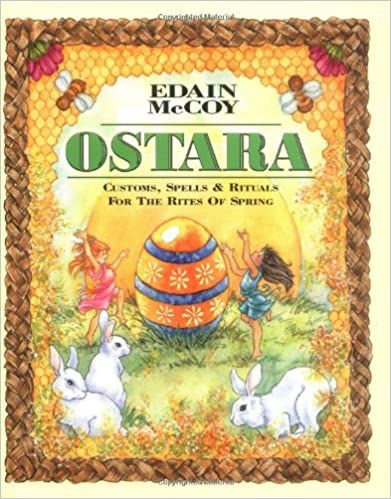Yellow • This is the color of creativity, mind power, intellectual pursuits, communication, and the solar plexus region of the body. It is also associated with the sun and with egg yolks.
Orange • Orange is another solar color. It is used in spells for attraction and friendship. Spells for willpower often use orange, as this is the color of the navel-area energy center, called a chakra, the area in the body governing personal desire and drive.
Red • Red is the color of blood, and this fact links it symbolically with the cycles of life, death, and rebirth. In the Greek Orthodox Church, eggs dyed deep red are used to decorate altars in homes and churches, and are given away as gifts after the traditional Easter Eve church service. The Druid priests of the Celtic tribes were reputed to have used red eggs in a similar manner. Red is also the color of desire, courage, lust, sexuality, war, and strength, and represents the womb blood of the Mother Goddess from which all things are born.
Green • This is the color of the Earth Mother in spring and summer. It represents abundance, prosperity, personal appearance, and fertility. Spells to neutralize difficult situations or induce calm often employ green. Green is linked to the energy center around the heart, so it's a natural that spells for love of all types work well under green's influence.
Blue • Blue represents sleep and dreams, peace and healing, and fidelity and unity, and is frequently employed in spells for dream magick and astral projection. Its paler shades are often associated with the coming of spring and with virgin goddesses.
Violet • This is the color of intense spirituality, metaphysical mysteries, deep sleep, the healing of serious illnesses, the uncovering of past lives, and of communicating with higher-level beings. This is also the color of the crown chakra of the body, which is activated when we seek a connection with the divine.
White • White is used in healing and purification spells and rituals. It is always perfect as an all-purpose color substitute when no other color feels quite right.
Brown • Brown represents the Earth and its animals, and is often used in connection with stone magick to help the inner self connect to the rhythms and energies of the Earth.
Black· Contrary to its reputation, black is not a color of evil or negativity. It represents mysteries, voids, and the Crone Goddess, and is used in spells to absorb and dispel negative influences. Though not a popular Ostara color, black should never be summarily dismissed as a magickal color choice when decorating eggs for spells or ritual. Even though it is associated with death in the West, it is symbolic of life in many parts of the East-and it should be remembered at Ostara that new life may only come from death, be it physical or metaphoric.
Pink • Like all pastels, pink is associated with spring. It is used primarily in spells and rituals for household peace and romantic love.
Silver • Silver represents the moon, the Goddess, psychicism, and the inner self.
Gold· Gold can represent the solar deities, both male and female. It is also used in summer festivals, in rituals to honor the sun, and in spells for wealth and employment.



